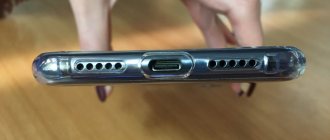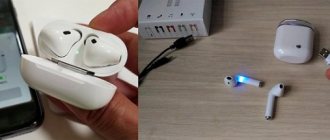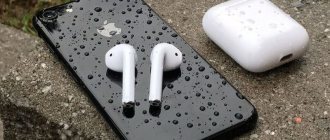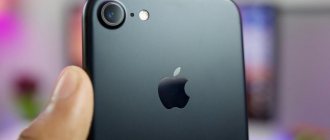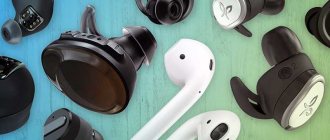At the dawn of mobile phones, the most common question that could be heard in a fictitious office of a fictitious company was whether there was a suitable charger. Those days are long gone, and now the question will be: do you have an Android or iPhone charger? Indeed, the world is divided into two camps: micro-USB and Lighting, as iPhone charging is called. If everything is clear with the first ones - they are used in most gadgets from smartphones to digital cameras, then with the 8-pin connector the situation is somewhat more complicated. In fact, its connection versatility is just the tip of the iceberg.
What connector does the iPhone have?
iPhone smartphone connectors have undergone evolution throughout their history, getting rid of outdated standards and arriving at the most optimal solution to the task: to be the first in new technologies. Below is a brief excursion into the history of what kind of charging connector the iPhone had from model to model.
However, first it is worth mentioning the very first type of “Apple” connector. We are talking about a 30-pin plug, which is memorable to many for its size. It was present in all iPhone models up to the fourth version, until the energy consumption of smartphone components required an increase in battery size. And purely aesthetically, the Lighting connector is much better.
Is there a headphone jack for iPhone 7?
iPhone 7 revolutionized the smartphone industry, once and for all getting rid of a standard that was nearly 50 years old at the time. The fact is that the iPhone 7, released in 2016, does not have a 3.5 mm headphone jack, better known as a “mini-jack” and so named because jack means “socket” in English.
The familiar mini-jack connector
However, Apple's designers did not leave their users without an alternative. For example, in order to listen to music, you can use special headphones with a Lighting connector, or purchase special wireless headphones Air Pods, the presentation of which was timed to coincide with the release of the 7th version of the iPhone.
For your information! This headset uses the Bluetooth protocol in its work and is essentially a further development of the “hands free” idea.
The developers explained their step by saying that by getting rid of the audio output, they received additional space inside the smartphone, which they were able to use to solve specific problems:
- Increase the battery life from one charge by increasing the size of the battery itself.
- Insert an additional camera with a telephoto lens, thanks to which photos from the iPhone began to turn out better.
- Sealing the case made it possible to apply the IP67 standard: now the smartphone can be immersed in water to a depth of 1 meter for half an hour.
- The iPhone itself became thinner, since none of its components were as wide as the audio jack.
- It was possible to equip the “Home” button with a special device that recognized the degree of finger pressure on it.
In addition, an analog audio signal was transmitted through the mini-jack, the eternal companions of which were extraneous noise and interference. Now, the use of modern technologies has made it possible to use a digital signal when playing media, which allows you to “prepare” the sound: apply noise reduction, achieve better purity, and the like.
iPhone 8 headphone jack
There were no innovations in the next iPhone model: the standard headphone jack never returned, and the owners of the new version of the smartphone could only come to terms with this fact. The kit included headphones with a Lighting connector; in addition, you could listen to music through a special adapter from regular headphones or buy wireless ones.
What connector does iPhone 10 have?
The tenth iPhone model did not acquire a USB C-type connector, so in order to connect your smartphone to your MacBook, which has such a port, you will have to use a special adapter, at one end of which there is a Lighting connector.
What is special about the Lightning connector for iPhone?
Of course, Apple loyalists will say that the main advantage of the 8-pin charging cable is that it can be inserted in either direction. Spiteful critics will not fail to mention the high cost of this accessory: two to three times more expensive than the original micro-USB.
How to connect Airpods to iPhone: setting up wireless headphones
In reality, both camps will be right, and for the same reason. The fact is that a small microprocessor is hidden in the Lighting connector. A miniature integrated circuit determines which side the cable is inserted in and checks it for compliance with company standards. A regular cord for Android does not have such complications; at best, it’s just four shielded wires soldered to the plug itself.
Each of Apple's certified accessories has its own unique code, and a list of these codes is embedded in iOS. When a cable is connected, the system calculates this unique identifier (it is stored in a special connector chip) and compares it with its own database. Here identification takes place on the principle of “friend or foe”, after which permission is given to charge or transfer data.
To avoid being trapped by its own foresight, Apple regularly updates the list of codes when updating the operating system.
For your information! The chip can be rewritten up to a million times.
Now it becomes clear that whatever connector the iPhone has is convenient, its comprehensive connectivity and high cost are directly related. The ability to connect from any side is due to the complex filling of the connector itself, which dictates the increased cost of this component.
Your iPhone doesn't have a 3.5mm output? It's not a problem.
Apple's refusal to use the traditional 3.5mm headphone output in the iPhone 7 and iPhone 7 Plus once became a bone of contention. Why was it necessary to remove the audio output and what is good about the Lightning connector?
Even two years later, not everyone has forgiven the company for this unexpected step.
The absence of a 3.5mm jack on the iPhone 8, 8 Plus, iPhone X, iPhone XS, iPhone XR and iPhone XS Max confirmed that Apple's break with the ubiquitous audio output was no accident.
Where Apple goes, everyone else has to follow. Even if you're not a fan of the company's devices, you can't help but admit that this decision caused a chain reaction throughout the entire consumer electronics segment.
So why did Apple get rid of the jack on the iPhone, and what does this mean for the new iPhone models, for iPhone headphones, and for the overall headphone market? Now we'll tell you.
When did the Lightning connector appear in Apple models?
The Lightning port was introduced to the public in September 2012 on the iPhone 5; It replaces the 30-pin connector previously used to charge all previous iPhones and iPods - but its introduction has not yet been accompanied by the abandonment of the 3.5mm headphone output.
After the announcement of Lightning, the industry had to reorient itself on the fly; Among other changes, it was necessary to release new docking stations and accessories equipped with a more compact connector. Apple released an adapter that allowed you to continue using devices with a 30-pin port, but it was only suitable for Lightning docks and speakers.
Since the discontinuation of the iPod Classic in September 2014, there are no more Apple devices with a 30-pin connector on the market.
This story caused a lot of noise at one time, but gradually everyone got used to this state of affairs.
Without a doubt, the company was counting on a similar development when releasing the iPhone 7 in September 2016 without the usual headphone output. To alleviate the pain of parting with it for owners of wired headphones, an adapter from Lightning to 3.5 mm was included in the kit.
However, recent versions of the iPhone (including the XS, XS Max and XR) do not come with an adapter, meaning users must either buy one for £9, use wireless headphones, or begrudgingly fork out for a pair of Lightning headphones.
Lightning MFi - what is it?
When discussing Lightning cables and other Apple accessories, the term MFi is often used. This abbreviation stands for Made For iPhone/iPod/iPad and refers to a certification program that was launched by Apple back in 2005. To obtain an MFi certificate, an accessory manufacturer must meet a number of requirements for product reliability and quality. After receiving this certificate, the manufacturer can use the MFi logo on its products.
The MFi logo guarantees the user that this accessory has been tested, is completely safe and supports all necessary operating modes. For example, in the case of cables, MFi means that such a cable can be used both to charge the device and to synchronize it with a computer. The presence of a certificate is verified using a special chip located inside the device. If there is no such chip, or it does not work correctly, the user will receive a message that the accessory is not supported.
Therefore, when choosing a new cable or accessory for Apple mobile technology, it is very advisable to choose a model with the MFi designation. Of course, this does not give a 100 percent guarantee that the purchase will not disappoint, but at least the likelihood of this will be minimal.
USB-C in iPhone 12 instead of Lightning
The 3.5mm jack wasn't that obsolete when the iPhone got rid of it. The same cannot be said about Lightning - now all Macs and iPad Pros (and soon the regular iPad) have a USB-C port for charging and data transfer. But Apple continues to promote “lightning”, it’s not entirely clear why.
The abandonment of the minijack also made it possible to improve water resistance ; previously, water very often got in there, and it was simply impossible to dive into the pool with such a connector. Although liquids getting into the iPhone are currently not covered by the warranty, you can at least drop your phone in water without fear that something serious will happen to it.
The same thing happened with the Home button - Apple took and removed the physical element, replacing it with an imitation using the Haptic Engine.
Now that Apple has removed unnecessary elements from iPhones, it can switch from Lightning to USB-C. This sounds logical, because USB-C will make the iPhone more universal - for example, you can charge the phone using an iPad charger. Or even from a MacBook. Carry fewer cables with you.
Although an alleged iPhone 12 charging cable has already appeared on the Internet, so far no one except a secret group inside Apple knows what it will look like. But it's time to give up Lightning. Or with all ports in general?
iPhone 12 without connectors
Recently, there have been many more supporters of rumors that the new iPhone may not have connectors at all . This will help simplify production and improve water resistance. And also reduce the complexity of repairs and mechanical breakdowns. To prevent people from plugging cables that fray into ports that are wet or dirty. And, of course, to prevent attackers from connecting the cable to try to extract the user's personal data.
If Apple removes the Lightning port from the iPhone and doesn't include USB-C, we'll obviously only have to charge the phone wirelessly. More precisely, in fact, it is not wireless at all - you still connect the charger to the outlet with a cable, and then place the iPhone on it. This kind of charging is just convenient - you can quickly put your phone on or take it off to start using it.
Wireless charging is not yet an ideal solution
Android phones have been charging this way for many years. Apple added wireless charging for the first time to the iPhone 8 and iPhone X, and thankfully it's sticking with the Qi standard. This allows you to buy any wireless chargers to your liking.
However, the charging speed this way is not yet as good as using a cable. And if Apple had decided to take such a step, it would not have developed new power adapters with fast charging for the iPhone. In addition, it is not yet completely clear whether wireless charging affects the battery life: for some, the maximum capacity with such charging is greatly reduced in a couple of months, in other cases - no more than when connected via cable.
What is dangerous about fake Lightning for iPhone?
A logical question arises: why do Cupertino go to such lengths to ensure that users use only certified cables? In addition to the most obvious - increasing income through the sale of accessories produced by the company itself or under its license, there are several more.
How to choose an application for wireless headphones on iPhone
First, it is the protection of patents owned by Apple. The small 8-pin connector contains several technological solutions developed by its own designers. It is quite natural that a manufacturer seeks to protect its intellectual property.
However, strange as it may seem to some, the main reason is concern for the owners of iPhone smartphones. The fact is that lithium-ion batteries, which are used in modern smart phones, are extremely sensitive to charging current. If charging conditions are not met, they tend to spontaneously ignite or even explode.
Important! There is a danger that an uncertified cable connected to the outlet will not charge the battery correctly. As a result, the smartphone will refuse to turn on.
However, this is not the worst case. It’s much worse if the battery simply catches fire or explodes at one “wonderful” moment. If at this time the owner was having a telephone conversation, then he risks getting burns or causing irreparable damage to his health.
Consequences of using a bad cable
Indirect confirmation that Apple's protection policy is bearing fruit is the almost complete absence of cases of inadvertent battery fire.
At the same time, similar incidents with smartphones running Android are observed all the time. The reason is a complete lack of control over the production of USB cables and a large number of low-quality components.
When using a non-original cable, the verification procedure described above occurs. If you use a non-original accessory, the message “This cable or accessory is not certified and is not guaranteed to work reliably with this iPhone” appears on the smartphone screen. It turns out that the purchased connector can be thrown into the trash bin as unnecessary.
Important! Even if a homemade cable can pass the test, it will work until the next system update, when the database with keys is completely changed. After this, the cable will absolutely not work.
Another big disadvantage of using a Lighting connector without the appropriate certification is the low quality of the materials used and the lack of output control. Such an accessory will quickly become unusable: the plastic insulation cracks, the plug itself becomes loose over time and a large gap appears. It turns out that the initial savings will result in a repeat purchase, while the original cable will last many times longer.
A cracked cable increases the risk of a short circuit
In addition, it should be said that such a damaged power cord creates the danger of improper charging of the battery, which is not far from an explosion.
How about wireless headphones for iPhone XS?
Of course, with new versions of the iPhone you can use not only headphones with Lightning, but also those that support Bluetooth.
There are many great models on the market today, including the Cambridge Audio Melomania 1, Sony WF-1000XM3, AKG Y50BT, B&W P5 Wireless and Sennheiser Momentum 2.0 Wireless. Along with the release of the iPhone 7, Apple announced the first wireless earbuds – Apple AirPods.
We weren't completely thrilled with the look and sound of the first version, but the second generation of AirPods from 2022 has radically improved the sound quality. The Airpods launched a boom in fully wireless headphones, including the Bose SoundSport Wireless, Sennheiser Momentum True Wireless, Sony WF-1000X and B&O BeoPlay 8.
Beats also has quite a few wireless models in its catalog, including Beats Powerbeats Pro, Beats X, Beats Solo 3 Wireless and Powerbeats 3 Wireless.
